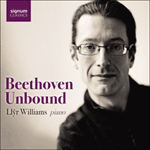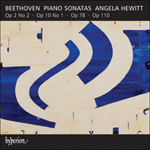
Welcome to Hyperion Records, a British classical label devoted to presenting high-quality recordings of music of all styles and from all periods from the twelfth century to the twenty-first.
Hyperion offers both CDs, and downloads in a number of formats. The site is also available in several languages.
Please use the dropdown buttons to set your preferred options, or use the checkbox to accept the defaults.
 PERFORMANCE
PERFORMANCE RECORDING
RECORDINGBeethoven himself never had such a problem. His beginnings are always terrific. The Piano Sonata in A major, Op 2 No 2, is a case in point. He wrote it in 1795 when he had just finished his counterpoint studies with Albrechtsberger (a famous music theorist and at the time Kapellmeister at St Stephen’s Cathedral in Vienna). Although the Allegro vivace opens piano and in unison octaves, it is lively and alert, and some beautiful counterpoint ensues beginning in the ninth bar. In spirit it may be Haydnesque (the sonata was dedicated to Beethoven’s former teacher), but even though this is an early work it couldn’t be written by anyone else. Strong dynamic contrasts, a lyrical second subject, virtuoso passages bristling with energy (and some original Beethoven fingering that shows he must have had huge hands!), dramatic changes of key—all the traits of the young Beethoven are here in abundance. I am not the only pianist not to observe the second repeat; I have tried, but it never seemed to make any sense.
The second movement, Largo appassionato, is simply beautiful. Czerny speaks of its ‘religious character’, and the ‘choral-like swelling of the harmony’. The trick is to make the chords as legato as possible with the fingers, avoiding the pedal in order to keep the bass pizzicato, while keeping the long musical line. Even here it is important to follow carefully the contrapuntal lines in the passages between the statements of the theme. When the key suddenly turns to D minor instead of major, a truly orchestral sound is needed.
Beethoven’s early sonatas more often than not had four movements—already a departure from the norm. A scherzo follows, marked Allegretto, which can seem quite frivolous, but it is not easy to get every note in the opening gesture to sparkle as it should, especially when presented by the left hand. The ensuing trio in the minor key is much more dramatic with its sudden fortissimos. I feel that the repeats should be observed in the da capo—especially in the first section, which would otherwise be far too short.
A good dose of Viennese charm helps the interpretation of the final movement of this beautiful sonata. The tempo marking is Grazioso, which of course isn’t a tempo at all. Nothing would be worse, though, than to rattle it off too quickly; one can save any rattling for the middle section, in which Beethoven releases a ‘hail-storm’ (to quote Tovey) of triplets. With each reappearance of the rondo theme the ornamentation becomes more elaborate, with a particularly affecting version at the end before the sonata’s gentle close. Perhaps the quiet ending is one reason this sonata isn’t performed as often as it should be.
from notes by Angela Hewitt © 2015
Beethoven lui-même ne connut jamais un tel problème. Ses œuvres commencent toujours merveilleusement bien. La Sonate pour piano en la majeur, op.2 nº 2, en est un exemple typique. Il la composa en 1795, date à laquelle il venait de terminer ses études de contrepoint avec Albrechtsberger (célèbre théoricien de la musique, alors Kapellmeister à la Cathédrale Saint-Étienne de Vienne). Même si l’Allegro vivace commence piano et en octaves à l’unisson, il est alerte et plein d’entrain; un magnifique contrepoint vient ensuite à partir de la neuvième mesure. L’esprit peut faire penser à Haydn (cette sonate est dédiée à l’ancien professeur de Beethoven), mais même s’il s’agit d’une œuvre de jeunesse, elle est signée sans la moindre ambiguïté. De forts contrastes dynamiques, un second sujet lyrique, des passages virtuoses débordant d’énergie (et quelques doigtés originaux de Beethoven qui montrent qu’il devait avoir des mains énormes!), des changements spectaculaires de tonalité—on trouve ici à profusion tous les éléments caractéristiques du jeune Beethoven. Je ne suis pas la seule pianiste à ne pas observer la seconde reprise; j’ai essayé, mais elle n’a jamais semblé avoir le moindre sens.
Le deuxième mouvement, Largo appassionato, est absolument magnifique. Czerny parle de son «caractère religieux» et du «gonflement de l’harmonie comme dans un choral». L’astuce consiste à jouer les accords aussi legato que possible avec les doigts, en évitant la pédale afin de conserver la basse pizzicato, tout en gardant la longue ligne musicale. Même ici, il est important de suivre soigneusement les lignes contrapuntiques dans les passages entre les expositions du thème. Lorsque la tonalité passe soudain de ré majeur à ré mineur, il faut une sonorité vraiment orchestrale.
Le plus souvent, les premières sonates de Beethoven sont en quatre mouvements—déjà un écart par rapport à la norme. Un scherzo suit, marqué Allegretto, qui peut paraître assez frivole, mais il n’est pas facile de faire étinceler chaque note du geste initial comme il le faut, surtout lorsqu’elles se présentent à la main gauche. Le trio suivant, en mineur, est beaucoup plus dramatique avec ses fortissimos soudains. Je pense que les reprises doivent être observées au da capo—surtout dans la première section qui, sinon, serait trop courte.
Une bonne dose de charme viennois contribue à l’interprétation du mouvement final de cette magnifique sonate. Le tempo indiqué est Grazioso, ce qui bien sûr n’est pas du tout un tempo. Mais rien ne pourrait être pire que de le débiter à toute vitesse, trop vite; on peut réserver une allure vive pour la section centrale où Beethoven lâche «une averse de grêle» de triolets (selon Tovey). À chaque réapparition du thème du rondo, l’ornementation devient plus élaborée, avec une version particulièrement émouvante à la fin avant la conclusion en douceur de la sonate. Cette fin calme explique peut-être pourquoi cette sonate n’est pas jouée aussi souvent qu’elle le devrait.
extrait des notes rédigées par Angela Hewitt © 2015
Français: Marie-Stella Pâris
Beethoven selbst war nie von derartigen Problemen geplagt. Seine Anfänge sind immer hervorragend. Die Klaviersonate in A-Dur, op. 2 Nr. 2, ist ein typisches Beispiel dafür. Sie entstand 1795, als Beethoven gerade sein Kontrapunkt-Studium bei Albrechtsberger (der nicht nur ein berühmter Musiktheoretiker, sondern zu jener Zeit auch Kapellmeister am Wiener Stephansdom war) abgeschlossen hatte. Obwohl das Allegro vivace im Piano und mit Unisono-Oktaven beginnt, ist es doch munter und lebhaft, und ab dem neunten Takt entwickelt sich ein wunderschöner Kontrapunkt. Im Geiste mag die Sonate an Haydn erinnern (Beethoven hatte sie seinem ehemaligen Lehrer gewidmet), doch obwohl sie ein Frühwerk ist, könnte sie aus keiner anderen Feder stammen. Starke dynamische Kontraste, ein lyrisches zweites Thema, vor Energie geradezu sprühende virtuose Passagen (und einige original Beethoven-Fingersätze, die zeigen, dass er riesige Hände gehabt haben muss!), dramatische Tonartenwechsel—all die Charakteristika des jungen Beethoven sind hier in Hülle und Fülle vorhanden. Ich schließe mich den Pianisten an, die die zweite Wiederholung hier nicht beachten—ich habe beide Varianten ausprobiert, doch ist diese Wiederholung hier nicht überzeugend.
Der zweite Satz, Largo appassionato, ist einfach wunderschön. Czerny spricht von seinem „religiösen“ Charakter, der durch ein „choralmäßiges Anschwellen der Harmonie herauszuheben“ sei. Man muss hier die Akkorde am besten mit den Fingern so legato wie möglich spielen und das Pedal tunlichst vermeiden, damit das Pizzicato im Bass deutlich wird, während der lange musikalische Bogen erhalten bleibt. Selbst hier ist es wichtig, die Kontrapunktlinien in den Passagen zu verfolgen, in denen das Thema nicht erklingt. Wenn die Tonart plötzlich nach d-Moll (anstelle von Dur) wechselt, ist ein voller Orchesterklang vonnöten.
Die meisten frühen Sonaten Beethovens sind viersätzig angelegt—was bereits ein Abweichen von der Norm war. Es folgt ein Scherzo, welches mit Allegretto überschrieben ist und recht frivol wirken kann—doch ist es durchaus nicht leicht, alle Töne der Eröffnungsgeste so glänzen zu lassen, wie sie sollten, besonders in der linken Hand. Das darauffolgende Trio in der Molltonart ist mit seinen plötzlichen Fortissimo-Stellen deutlich dramatischer. Meiner Ansicht nach sollten die Da-capo-Wiederholungen beachtet werden, insbesondere im ersten Abschnitt, der sonst viel zu kurz wäre.
Ein gesundes Maß an Wiener Charme hilft bei der Interpretation des letzten Satzes dieser wunderschönen Sonate. Die Tempobezeichnung lautet Grazioso, was natürlich überhaupt kein Tempo ist. Nichts wäre jedoch schlimmer als den Satz zu schnell herunterzurasseln—jegliches Rasseln kann man sich für den Mittelteil aufsparen, wo Beethoven einen „Hagelsturm“ (um Tovey zu zitieren) in Triolen lostritt. Mit jedem Wiedererscheinen des Rondo-Themas wird die Ornamentation elaborierter, wobei gegen Ende, kurz vor dem sanften Schluss der Sonate, eine besonders bewegende Version erklingt. Vielleicht ist das leise Ende einer der Gründe dafür, dass diese Sonate nicht so oft aufgeführt wird wie sie es verdient hätte.
aus dem Begleittext von Angela Hewitt © 2015
Deutsch: Viola Scheffel
 Beethoven: Beethoven Unbound Beethoven: Beethoven UnboundA comprehensive new cycle of the Beethoven sonatas recorded live at London's Wigmore Hall during the pianist's epic fourth rendition of these masterpieces .» More |
 Beethoven: Piano Sonatas Opp 2/2, 10/1, 78 & 110 Beethoven: Piano Sonatas Opp 2/2, 10/1, 78 & 110Four crisp new sonatas take their place in Angela Hewitt’s ever-popular Beethoven repertoire.» More |

